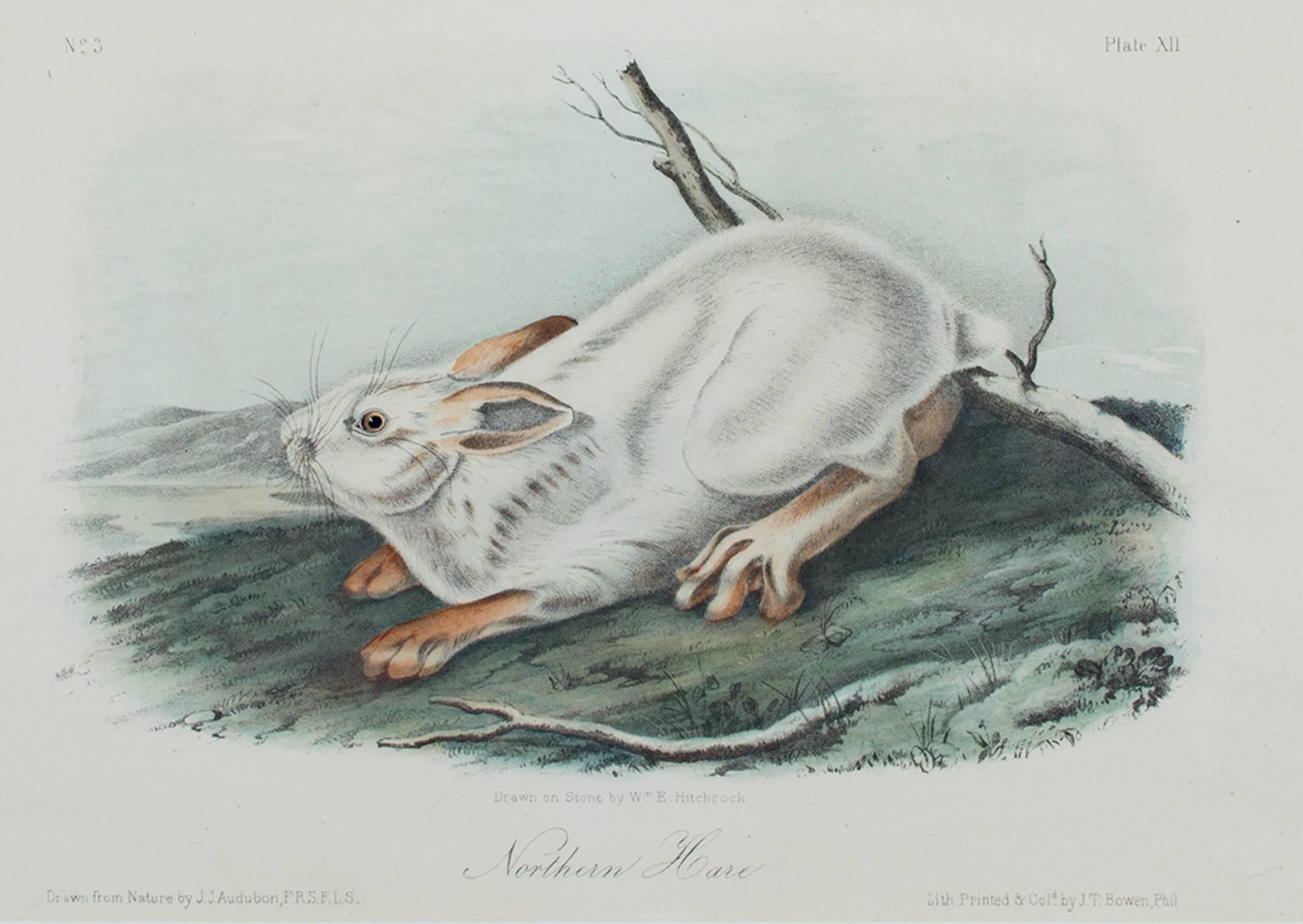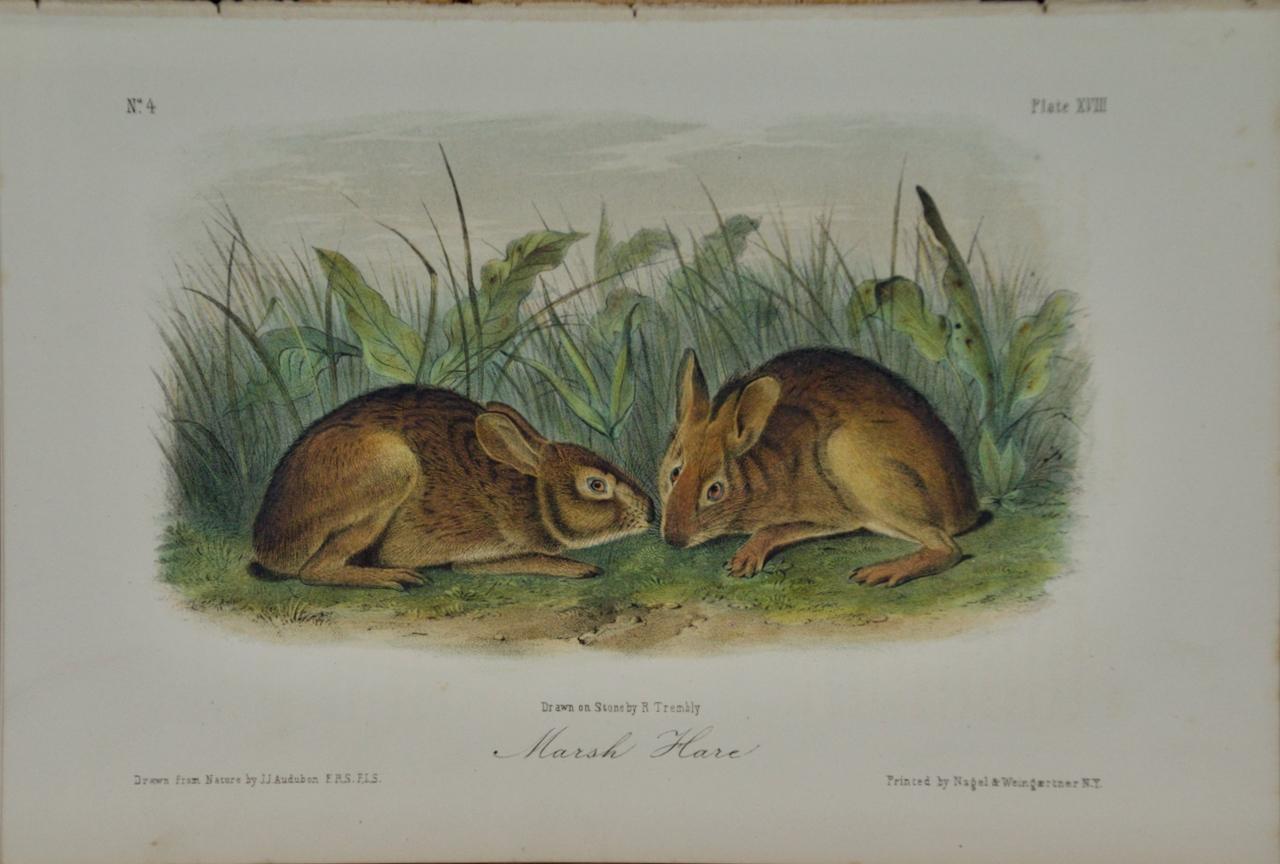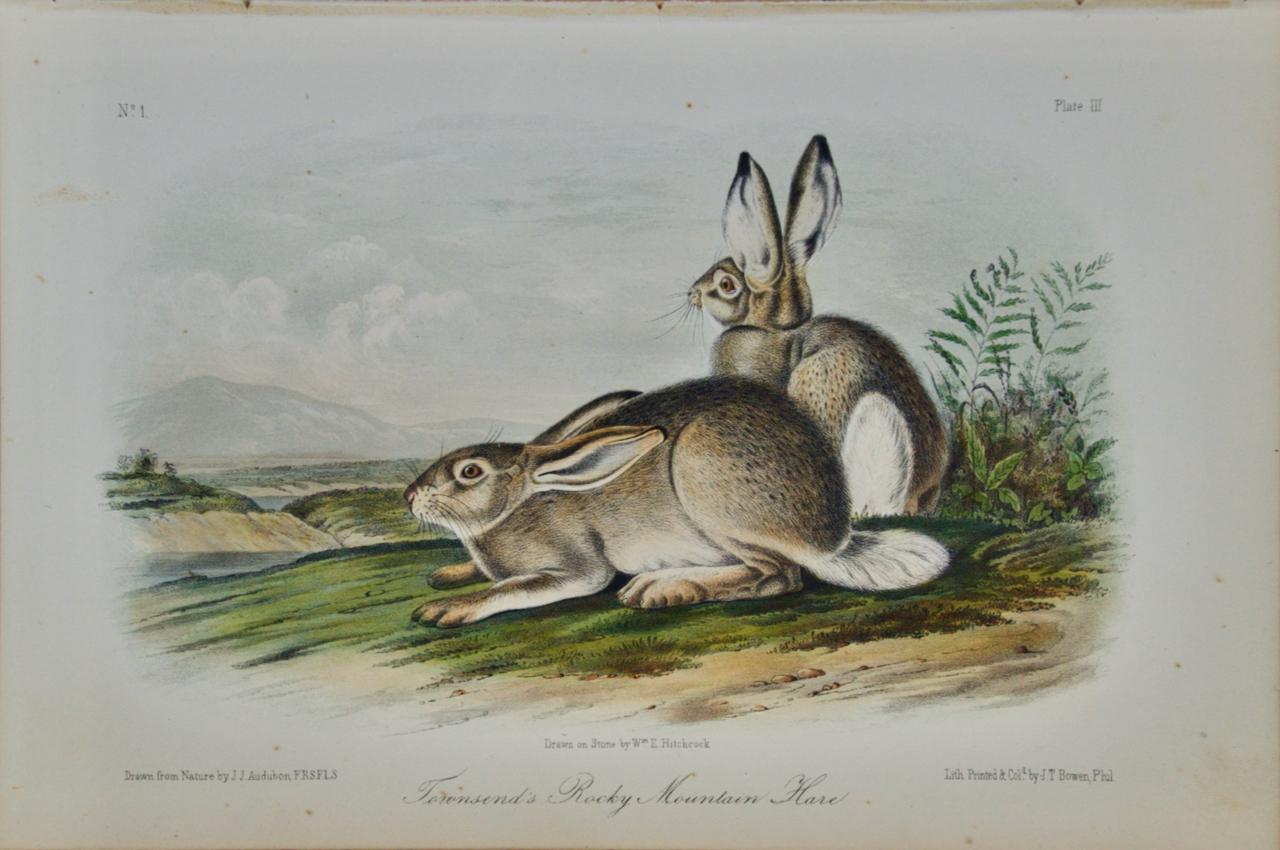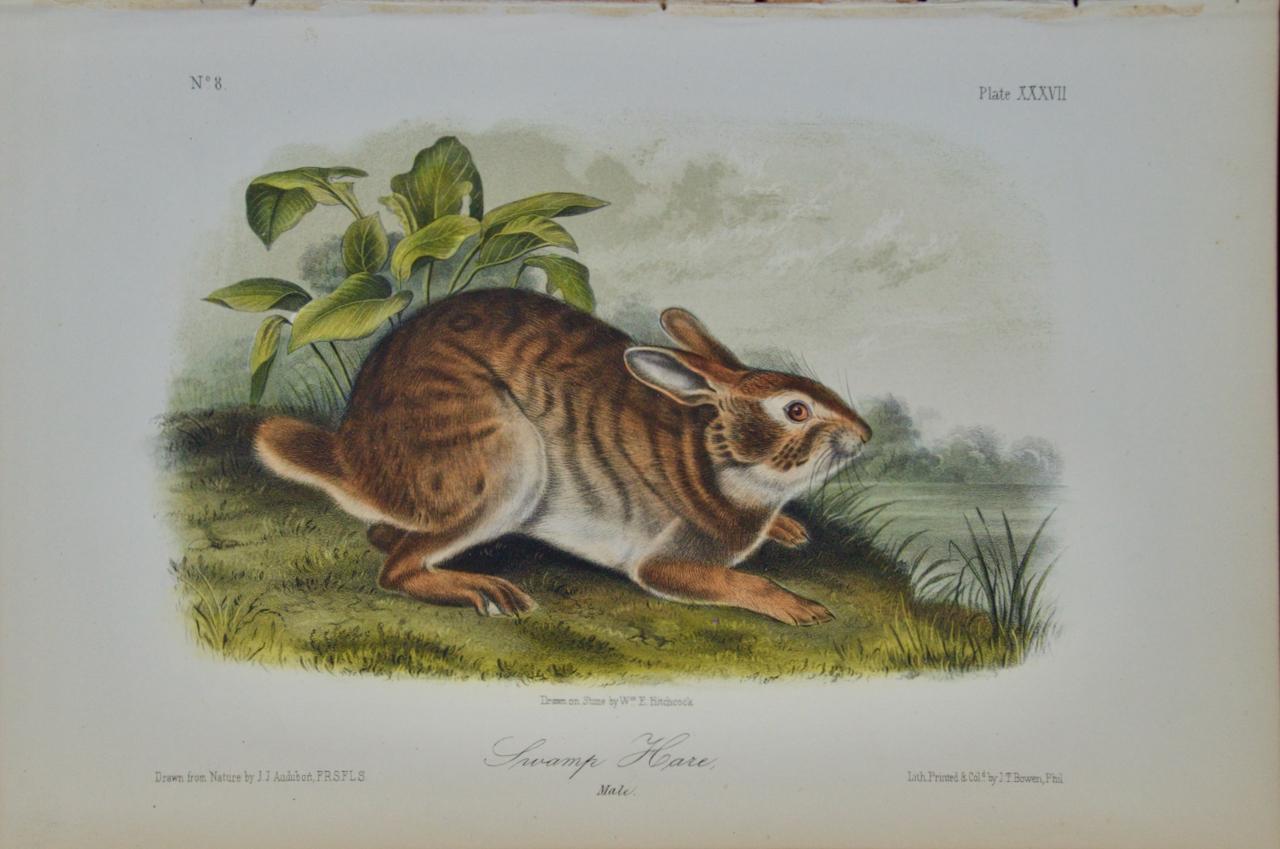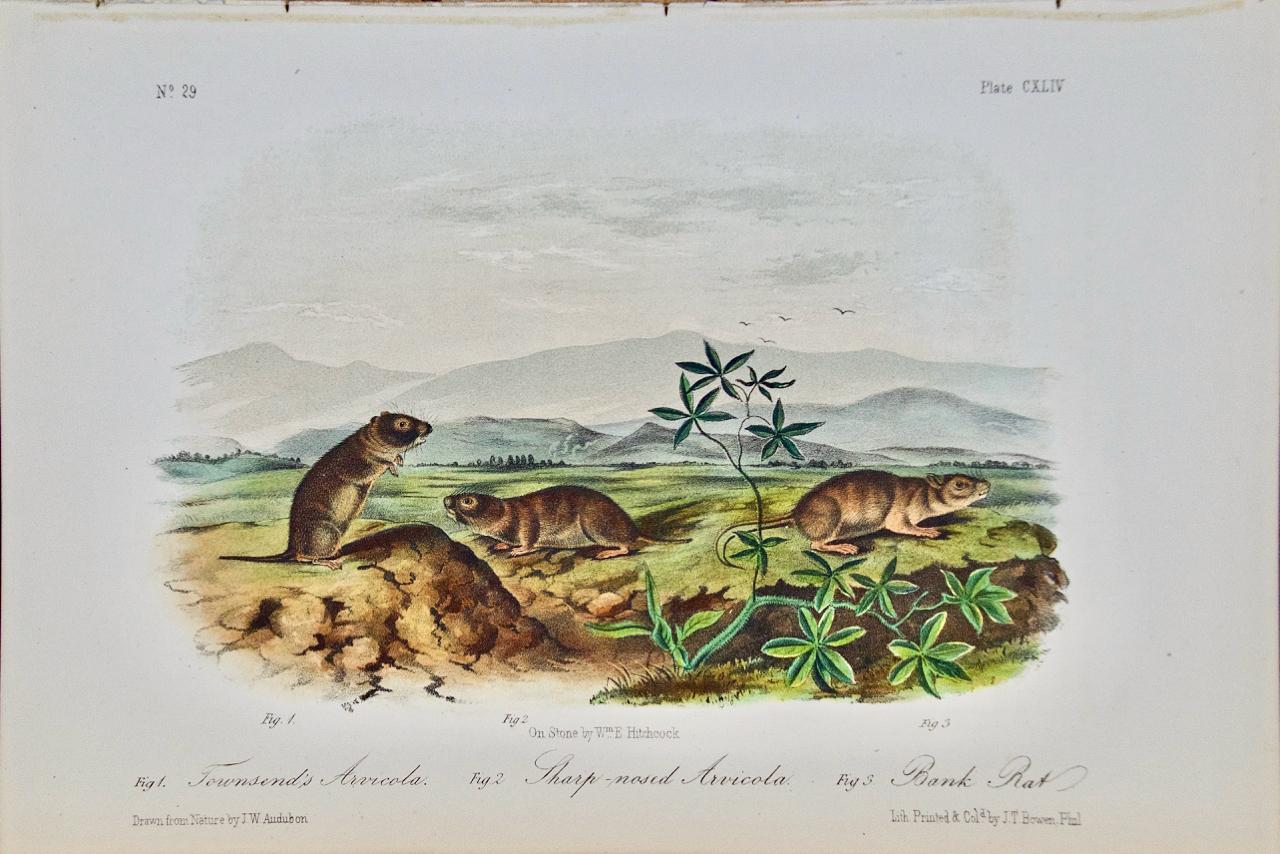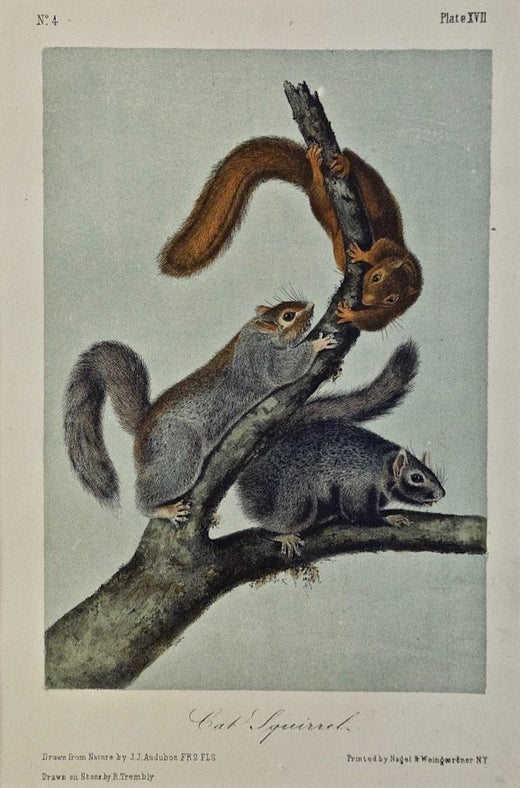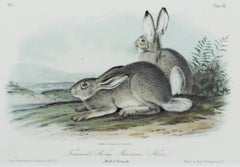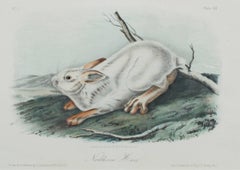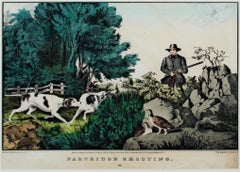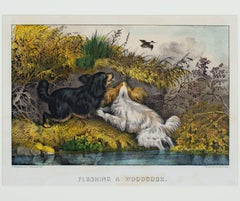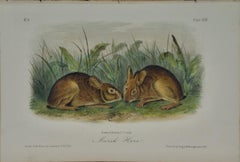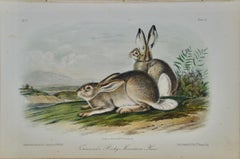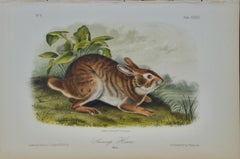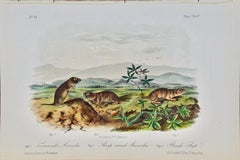Items Similar to 19th century color lithograph hare landscape grass animal print wildlife
Want more images or videos?
Request additional images or videos from the seller
1 of 11
John James Audubon19th century color lithograph hare landscape grass animal print wildlifecirca 1846
circa 1846
$1,690
£1,271.57
€1,469.06
CA$2,388.41
A$2,593.35
CHF 1,373.37
MX$31,787.04
NOK 16,995.98
SEK 16,060.30
DKK 10,964.49
About the Item
"Worm-Wood Hare" is an original color lithograph by John James Audubon. It depicts three brown rabbits in a landscape. No. 18, Plate LXXXVIII, On Stone by W.E. Hitchcock.
6" x 8" art
12" x 14 7/8" frame
John James Audubon was born in Haiti in 1785. He was the illegitimate son of Jean Audubon, a French merchant and sea captain, and Jeanne Rabine, a chambermaid who died in a slave uprising shortly after his birth. Raised lovingly by his stepmother and father, in the French countryside around Nantes, he developed a love of wildlife, especially birds, and of sketching. At age 18, Audubon was sent to Pennsylvania to avoid conscription in Napolean's army and to manage family farm property at Mill Grove, near Philadelphia.
Lucy Bakewell became his wife in 1808. Her unwavering support, through difficult financial and personal circumstances, proved critical to Audubon's ultimate success as an artist/naturalist. At age 35, Audubon embarked on The Birds of America, producing 435 hand-colored engravings and publishing double elephant folios (1828-1838), followed by a smaller, octavo-sized, version. While initiating the engraving process for The Birds of America, through Robert Havell, Jr. of London, Audubon lived in Europe (1827-1829). In Edinburgh, London, and Paris, he was elected to learned and scientific honorary societies, and his work was acclaimed in superlatives. He developed a noble and royal patronage, and a host of subscribers.
In 1840, he undertook publication of The Viviparous Quadrupeds of North America. By the time Audubon and his four assistants embarked on their journey up the Missouri River, in 1843, to collect information and images of western mammals, he had drawn 61 species. Although this expedition proved scientifically disappointing to John Bachman, 150 hand-colored lithographs were published in both an imperial folio size (1845-1848) and a smaller octavo edition (1846-1853).
Audubon died in 1851, with plates for the Quadrupeds, but not all of the text, completed.
- Creator:John James Audubon (1785-1851, American, French)
- Creation Year:circa 1846
- Dimensions:Height: 12 in (30.48 cm)Width: 14.875 in (37.79 cm)
- Medium:
- Period:
- Condition:
- Gallery Location:Milwaukee, WI
- Reference Number:Seller: 976d1stDibs: LU60532825983
John James Audubon
John James Audubon (April 26, 1785, Les Cayes, Saint-Domingue (later Haiti) – January 27, 1851 (aged 65) Manhattan, New York, U.S.), born Jean-Jacques Audubon, was an American ornithologist, naturalist, and painter. He was notable for his expansive studies to document all types of American birds and for his detailed illustrations that depicted the birds in their natural habitats. His major work, a color-plate book entitled The Birds of America (1827–1839), is considered one of the finest ornithological works ever completed. Audubon identified 25 new species.
About the Seller
4.9
Platinum Seller
Premium sellers with a 4.7+ rating and 24-hour response times
Established in 1966
1stDibs seller since 2017
442 sales on 1stDibs
Typical response time: 3 hours
- ShippingRetrieving quote...Shipping from: Milwaukee, WI
- Return Policy
Authenticity Guarantee
In the unlikely event there’s an issue with an item’s authenticity, contact us within 1 year for a full refund. DetailsMoney-Back Guarantee
If your item is not as described, is damaged in transit, or does not arrive, contact us within 7 days for a full refund. Details24-Hour Cancellation
You have a 24-hour grace period in which to reconsider your purchase, with no questions asked.Vetted Professional Sellers
Our world-class sellers must adhere to strict standards for service and quality, maintaining the integrity of our listings.Price-Match Guarantee
If you find that a seller listed the same item for a lower price elsewhere, we’ll match it.Trusted Global Delivery
Our best-in-class carrier network provides specialized shipping options worldwide, including custom delivery.More From This Seller
View All19th century color lithograph hares animal nature print wildlife
By John James Audubon
Located in Milwaukee, WI
"Townsend's Rocky Mountain Hare" is an original color lithograph by John James Audubon. This artwork features two gray hares in a muted, cool-colored landscape.
5 1/2" x 8 1/4" art...
Category
Mid-19th Century Academic Animal Prints
Materials
Lithograph
19th century color lithograph hare animal print wildlife
By John James Audubon
Located in Milwaukee, WI
"Northern Hare" is an original color lithograph by John James Audubon. This piece depicts a white rabbit in a cool green landscape.
5 3/4" x 7 3/4" art...
Category
1840s Other Art Style Animal Prints
Materials
Lithograph
19th century color lithograph watercolor landscape figurative animal print
By Nathaniel Currier
Located in Milwaukee, WI
The present hand-colored lithograph presents the viewer with a hunting scene in a picturesque landscape. In the foreground, a man approaches two partridges as his two pointers prepare to flush them out. Beyond, a white fence draws our eyes to the homestead in the distance. Images like this one show how people in the United States were trying to identify themselves as a new nation in the North American landscape - as separate from their European counterparts but with similar similar and specific wildlife and magesties of nature. It also identifies hunting in this landscape as an American pastime.
9.25 x 12.5 inches, artwork
18.38 x 22 inches, frame
Entitled bottom center "Partridge Shooting...
Category
Mid-19th Century Romantic Figurative Prints
Materials
Watercolor, Lithograph
19th century color lithograph dogs bird nature grass pastoral animals
By Currier & Ives
Located in Milwaukee, WI
"Flushing a Woodcock" is an original hand-colored lithograph published by Currier & Ives. It depicts two dogs at the edge of a pond going after a bird that has just flown into the air.
8" x 12 1/2" art
18 1/2" x 22 1/4" frame
Currier & Ives produced their prints in a building at 33 Spruce Street where they occupied the third, fourth and fifth floors. The third floor was devoted to the hand operated printing presses that were built by Nat's cousin, Cyrus Currier, at his shop Cyrus Currier & Sons in Newark, NJ. The fourth floor found the artists, lithographers and the stone grinders...
Category
1850s Animal Prints
Materials
Lithograph
19th century color lithograph birds landscape nature grass sky water figure
By Currier & Ives
Located in Milwaukee, WI
"Shooting on the Prairie" is an original hand-colored lithograph by Currier & Ives. It depicts a hunter shooting at fowl in an open field.
8 1/2" x 12 1/2" art
20 1/4" x 23 3/4" frame
Nathaniel Currier was a tall introspective man with a melancholy nature. He could captivate people with his piercing stare or charm them with his sparkling blue eyes. Nathaniel was born in Roxbury, Massachusetts on March 27th, 1813, the second of four children. His parents, Nathaniel and Hannah Currier, were distant cousins who lived a humble yet spartan life. When Nathaniel was eight years old, tragedy struck. Nathaniel’s father unexpectedly passed away leaving Nathaniel and his eleven-year-old brother Lorenzo to provide for the family. In addition to their mother, Nathaniel and Lorenzo had to care for six-year-old sister Elizabeth and two-year-old brother Charles. Nathaniel worked a series of odd jobs to support the family, and at fifteen, he started what would become a life-long career when he apprenticed in the Boston lithography shop of William and John Pendleton.
A Bavarian gentleman named Alois Senefelder invented lithography just 30 years prior to young Nat Currier’s apprenticeship. While under the employ of the brothers Pendleton, Nat was taught the art of lithography by the firm’s chief printer, a French national named Dubois, who brought the lithography trade to America.
Lithography involves grinding a piece of limestone flat and smooth then drawing in mirror image on the stone with a special grease pencil. After the image is completed, the stone is etched with a solution of aqua fortis leaving the greased areas in slight relief. Water is then used to wet the stone and greased-ink is rolled onto the raised areas. Since grease and water do not mix, the greased-ink is repelled by the moisture on the stone and clings to the original grease pencil lines. The stone is then placed in a press and used as a printing block to impart black on white images to paper.
In 1833, now twenty-years old and an accomplished lithographer, Nat Currier left Boston and moved to Philadelphia to do contract work for M.E.D. Brown, a noted engraver and printer. With the promise of good money, Currier hired on to help Brown prepare lithographic stones of scientific images for the American Journal of Sciences and Arts. When Nat completed the contract work in 1834, he traveled to New York City to work once again for his mentor John Pendleton, who was now operating his own shop located at 137 Broadway. Soon after the reunion, Pendleton expressed an interest in returning to Boston and offered to sell his print shop to Currier. Young Nat did not have the financial resources to buy the shop, but being the resourceful type he found another local printer by the name of Stodart. Together they bought Pendleton’s business.
The firm ‘Currier & Stodart’ specialized in "job" printing. They produced many different types of printed items, most notably music manuscripts for local publishers. By 1835, Stodart was frustrated that the business was not making enough money and he ended the partnership, taking his investment with him. With little more than some lithographic stones, and a talent for his trade, twenty-two year old Nat Currier set up shop in a temporary office at 1 Wall Street in New York City. He named his new enterprise ‘N. Currier, Lithographer’
Nathaniel continued as a job printer and duplicated everything from music sheets to architectural plans. He experimented with portraits, disaster scenes and memorial prints, and any thing that he could sell to the public from tables in front of his shop. During 1835 he produced a disaster print Ruins of the Planter's Hotel, New Orleans, which fell at two O’clock on the Morning of the 15th of May 1835, burying 50 persons, 40 of whom Escaped with their Lives. The public had a thirst for newsworthy events, and newspapers of the day did not include pictures. By producing this print, Nat gave the public a new way to “see” the news. The print sold reasonably well, an important fact that was not lost on Currier.
Nat met and married Eliza Farnsworth in 1840. He also produced a print that same year titled Awful Conflagration of the Steamboat Lexington in Long Island Sound on Monday Evening, January 18, 1840, by which melancholy occurrence over One Hundred Persons Perished. This print sold out very quickly, and Currier was approached by an enterprising publication who contracted him to print a single sheet addition of their paper, the New York Sun. This single page paper is presumed to be the first illustrated newspaper ever published.
The success of the Lexington print launched his career nationally and put him in a position to finally lift his family up. In 1841, Nat and Eliza had their first child, a son they named Edward West Currier. That same year Nat hired his twenty-one year old brother Charles and taught him the lithography trade, he also hired his artistically inclined brother Lorenzo to travel out west and make sketches of the new frontier as material for future prints. Charles worked for the firm on and off over the years, and invented a new type of lithographic crayon which he patented and named the Crayola. Lorenzo continued selling sketches to Nat for the next few years.
In 1843, Nat and Eliza had a daughter, Eliza West Currier, but tragedy struck in early 1847 when their young daughter died from a prolonged illness. Nat and Eliza were grief stricken, and Eliza, driven by despair, gave up on life and passed away just four months after her daughter’s death.
The subject of Nat Currier’s artwork changed following the death of his wife and daughter, and he produced many memorial prints and sentimental prints during the late 1840s. The memorial prints generally depicted grief stricken families posed by gravestones (the stones were left blank so the purchasers could fill in the names of the dearly departed). The sentimental prints usually depicted idealized portraits of women and children, titled with popular Christian names of the day.
Late in 1847, Nat Currier married Lura Ormsbee, a friend of the family. Lura was a self-sufficient woman, and she immediately set out to help Nat raise six-year-old Edward and get their house in order. In 1849, Lura delivered a son, Walter Black Currier, but fate dealt them a blow when young Walter died one year later. While Nat and Lura were grieving the loss of their new son, word came from San Francisco that Nat’s brother Lorenzo had also passed away from a brief illness. Nat sank deeper into his natural quiet melancholy. Friends stopped by to console the couple, and Lura began to set an extra place at their table for these unexpected guests. She continued this tradition throughout their lives.
In 1852, Charles introduced a friend, James Merritt Ives, to Nat and suggested he hire him as a bookkeeper. Jim Ives was a native New Yorker born in 1824 and raised on the grounds of Bellevue Hospital where his father was employed as superintendent. Jim was a self-trained artist and professional bookkeeper. He was also a plump and jovial man, presenting the exact opposite image of his new boss.
Jim Ives met Charles Currier through Caroline Clark, the object of Jim’s affection. Caroline’s sister Elizabeth was married to Charles, and Caroline was a close friend of the Currier family. Jim eventually proposed marriage to Caroline and solicited an introduction to Nat Currier, through Charles, in hopes of securing a more stable income to support his future wife.
Ives quickly set out to improve and modernize his new employer’s bookkeeping methods. He reorganized the firm’s sizable inventory, and used his artistic skills to streamline the firm’s production methods. By 1857, Nathaniel had become so dependent on Jims’ skills and initiative that he offered him a full partnership in the firm and appointed him general manager. The two men chose the name ‘Currier & Ives’ for the new partnership, and became close friends.
Currier & Ives produced their prints in a building at 33 Spruce Street where they occupied the third, fourth and fifth floors. The third floor was devoted to the hand operated printing presses that were built by Nat's cousin, Cyrus Currier, at his shop Cyrus Currier & Sons in Newark, NJ. The fourth floor found the artists, lithographers and the stone grinders at work. The fifth floor housed the coloring department, and was one of the earliest production lines in the country. The colorists were generally immigrant girls, mostly German, who came to America with some formal artistic training. Each colorist was responsible for adding a single color to a print. As a colorist finished applying their color, the print was passed down the line to the next colorist to add their color. The colorists worked from a master print displayed above their table, which showed where the proper colors were to be placed. At the end of the table was a touch up artist who checked the prints for quality, touching-in areas that may have been missed as it passed down the line. During the Civil War, demand for prints became so great that coloring stencils were developed to speed up production.
Although most Currier & Ives prints were colored in house, some were sent out to contract artists. The rate Currier & Ives paid these artists for coloring work was one dollar per one hundred small folios (a penny a print) and one dollar per one dozen large folios. Currier & Ives also offered uncolored prints to dealers, with instructions (included on the price list) on how to 'prepare the prints for coloring.' In addition, schools could order uncolored prints from the firm’s catalogue to use in their painting classes.
Nathaniel Currier and James Merritt Ives attracted a wide circle of friends during their years in business. Some of their more famous acquaintances included Horace Greeley, Phineas T. Barnum, and the outspoken abolitionists Rev. Henry Ward, and John Greenleaf Whittier (the latter being a cousin of Mr. Currier).
Nat Currier and Jim Ives described their business as "Publishers of Cheap and Popular Pictures" and produced many categories of prints. These included Disaster Scenes, Sentimental Images, Sports, Humor, Hunting Scenes, Politics, Religion, City and Rural Scenes, Trains, Ships, Fire Fighters, Famous Race Horses, Historical Portraits, and just about any other topic that satisfied the general public's taste. In all, the firm produced in excess of 7500 different titles, totaling over one million prints produced from 1835 to 1907.
Nat Currier retired in 1880, and signed over his share of the firm to his son Edward. Nat died eight years later at his summer home 'Lion’s Gate' in Amesbury, Massachusetts. Jim Ives remained active in the firm until his death in 1895, when his share of the firm passed to his eldest son, Chauncey.
In 1902, faced will failing health from the ravages of Tuberculosis, Edward Currier sold his share of the firm to Chauncey Ives...
Category
1870s Other Art Style Animal Prints
Materials
Lithograph
19th century color lithograph birds nature tree leaves nature scene signed
By Louis Prang
Located in Milwaukee, WI
"Weaver Birds" is an original color lithograph by Louis Prang. It depicts multiple weaver birds with leaves surrounding them.
8 1/4" x 5" image
12 1/2" x...
Category
Late 19th Century American Realist Animal Prints
Materials
Lithograph
You May Also Like
Marsh Hare: Original 19th Century 1st Octavo Ed. Audubon Hand-colored Lithograph
By John James Audubon
Located in Alamo, CA
This is an original 19th century John James Audubon hand-colored first octavo edition lithograph entitled "Marsh Hare", No. 4, Plate XVIII, 18, from Audubon's "Quadrupeds of North America", printed and colored by Nagel & Weingaertner and published in New York in 1849. It depicts a pair of Marsh Hares/rabbits, presumably a male and a female, lying on grass, nose to nose, with plants in the background.
This antique hand-colored Audubon quadruped lithograph has a few faint spots, but the print is otherwise in very good condition. The sheet measures 7" high and 10.5" wide. The descriptive text pages, 151-156, from Audubon's original publication are included.
John James Audubon (1785-1851) was a naturalist and artist. He was initially unsuccessful financially prior to the publication of his famous work “The Birds of America”, spending time in debtor’s prison...
Category
Mid-19th Century Naturalistic Animal Prints
Materials
Lithograph
Townsend's Rocky Mountain Hare: an Original Audubon Hand-colored Lithograph
By John James Audubon
Located in Alamo, CA
This is an original 19th century John James Audubon hand colored lithograph entitled "Townsend's Rocky Mountain Hare", No. 1, Plate III, from Audubon's "Quadrupeds of North America",...
Category
Mid-19th Century Naturalistic Animal Prints
Materials
Lithograph
Swamp Hare: an Original 19th Century Audubon Hand-colored Lithograph
By John James Audubon
Located in Alamo, CA
This is an original 19th century John James Audubon hand colored lithograph entitled "Swamp Hare", No. 8, Plate XXXVII, 37, from Audubon's "Quadrupeds...
Category
Mid-19th Century Naturalistic Animal Prints
Materials
Lithograph
Townsend's Arvicola: Original 19th Cent. Hand-colored Lithograph by Audubon
By John James Audubon
Located in Alamo, CA
This is an original John James Audubon hand-colored lithograph entitled "Townsend's Arvicola; Sharp-nosed Arvicola; Bank Rat", No. 31, Plate CXLIV from John James Audubon's Quadruped...
Category
Mid-19th Century Naturalistic Animal Prints
Materials
Lithograph
"Prairie Wolf": An Original Audubon 19th Century Hand-colored Lithograph
By John James Audubon
Located in Alamo, CA
This is an original John James Audubon hand-colored royal octavo lithograph entitled "Prairie Wolf", No. 15, Plate LXXI, 71 from Audubon's "Quadrupeds of North America". It was drawn...
Category
Mid-19th Century Naturalistic Animal Prints
Materials
Lithograph
"Northern Meadow Mouse" an Audubon Hand Colored by J.T. Bowen Lithograph
By John James Audubon
Located in Alamo, CA
An original 19th century John James Audubon hand colored lithograph entitled "Northern Meadow Mouse", No. 26, Plate CXXIX, 129, from Audubon's "Quadrupeds of North America", printed ...
Category
Mid-19th Century Naturalistic Animal Prints
Materials
Lithograph

